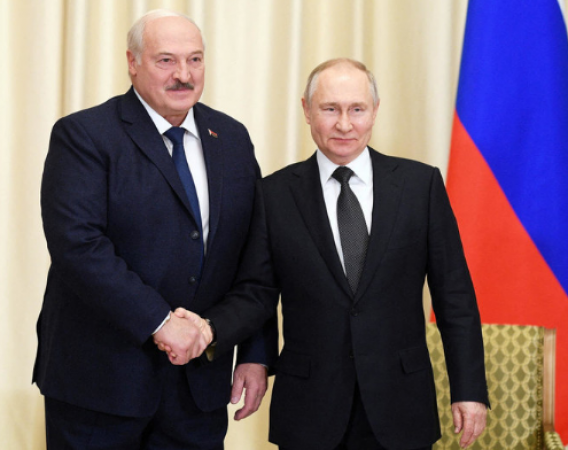
Moscow: Vladimir Putin, the president of Russia, warned the West by announcing plans to station tactical nuclear weapons in Belarus, a neighbouring country, on Saturday.
Putin claimed that Britain's decision to give Ukraine depleted uranium-tipped armor-piercing rounds last week was what precipitated the action. The Russian leader previously stated falsely that the rounds contain nuclear material.
He later became more diplomatic, but insisted that the ammunition posed an additional threat to Ukrainian troops and civilians in a state television interview that was aired Saturday night.
Also Read: Android users now have access to a new WhatsApp feature called single-play audio messages
Unlike more potent, farther-reaching strategic nuclear weapons, tactical nuclear weapons are designed for use on the battlefield. The construction of storage facilities for them will be finished by July 1, according to Putin, and Russia plans to maintain control over the ones it intends to send to Belarus.
How many nuclear weapons Russia would keep in Belarus was not specified by Putin. Russian tactical nuclear weapons are believed to number around 2,000, according to the US government. These weapons include bombs that can be carried by tactical aircraft, warheads for short-range missiles, and artillery rounds.
In his interview, Putin argued that the US had nuclear weapons stationed in Belgium, Germany, Greece, Italy, the Netherlands, and Turkey, and that by deploying tactical nuclear weapons in Belarus, Russia was simply following its example.
We are carrying out their decades-old practise of stationing them in certain allies, preparing the launch pads, and preparing the crews, according to Putin. "We're going to proceed in the same manner."
Moving some of the arsenal to a storage facility in Belarus would escalate the conflict in Ukraine by bringing them closer to the Russian aircraft and missiles already stationed there. Until now, Russia has kept its tactical nuclear weapons in designated depots on its own territory.
Also Read: Oil prices drop as the US delays adding to reserves
In order to convey to the West that Russia is ready to use its tactical nuclear weapons, some hawkish commentators in Russia have long urged the Kremlin to position the weapons close to one another.
Putin claimed that Alexander Lukashenko, the president of Belarus, has long requested nuclear weapons as a retaliation against NATO. Three NATO members, Latvia, Lithuania, and Poland, border Belarus, and on February 24, 2022, Russia used Belarus as a staging area to send troops into Ukraine.
Putin mentioned that last year, Russia assisted in modernising Belarusian military aircraft so they could be equipped with nuclear warheads. There were ten of these planes, he claimed. He claimed that the Iskander short-range missiles that Russia gave Belarus last year could also be used to launch nuclear weapons.
The agreement to transfer the tactical nuclear weapons to Belarus, according to exiled Belarusian opposition leader Sviatlana Tsikhanouskaya, "underlines the threat to regional security" posed by the Lukashenko regime.
"Until the dictator of Belarus is removed and brought before a court to answer for crimes against our nation and Ukraine, Europe won't be safe," Tsikhanouskaya wrote in English on Twitter.
Putin claimed in his interview on state television that the depleted uranium rounds that Britain had promised to deliver to Ukraine would leave a radioactive trail and contaminate farmland.
He claimed that those weapons were harmful to everyone who came into contact with them, including civilians and the environment. Putin added that despite having sizable stocks of similar ammunition, Russia has so far chosen not to use them.
Also Read: Oleg Deripaska: Extreme government spending will cause the US economy to collapse
A byproduct of the uranium enrichment procedure required to make nuclear weapons is depleted uranium. Although the rounds are unable to produce a nuclear reaction, they do emit small amounts of radiation. The potential risks of exposure have been noted by the UN nuclear watchdog.
Such rounds were created by the US during the Cold War to eliminate Soviet tanks, including the T-72 tanks that Ukraine is currently up against in its attempt to end a standoff in the east.